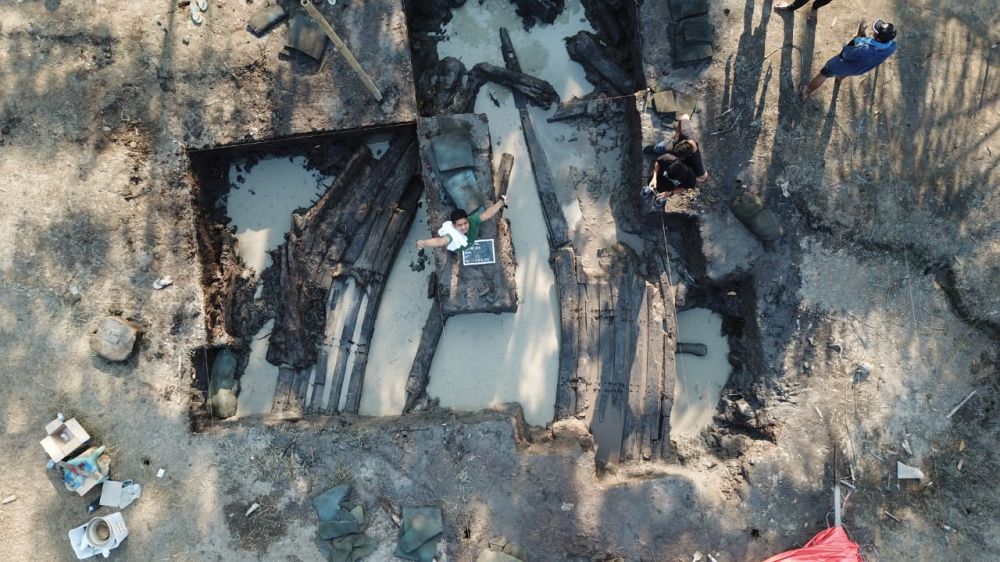Make it fascinated! Here are the 8 Most Amazing Archaeological Discovery in Asia
Have you ever imagined an archeological discovery that can make all researchers and archaeologists amazed?

Have you ever imagined an archeological discovery that can make all researchers and archaeologists amazed? Or maybe there was a discovery that instead made them surprised confused? Yep, of course there is. Because there are many artifacts or archeological objects that are stunning and spread throughout the world, including Asia. Well, this time we will distribute 8 of the most amazing archaeological discoveries in Asia. What discovery is there? Check the full list below.
1. Pillar Drift Lepakshi, India
It seems like the discovery of a unique temple in India named Lepshi is amazing. The temple in Andhra Pradesh was one of the pillars not touching the ground, so many who named the pillars of floating, amazing! Of a total of around 70 pillars, only one pillar was floating. Chances are because there are many pillars that sustain the temple, then the floating pillar does not interfere with the construction of the temple.
Lepakshi's temple itself is estimated to be built in the 16th century by 2 brothers named Viranna and Varupanna. According to folklore, the temple is related to the story of the Ramayana legend. In front of Lepakshi's temple there is also a large carving formed from stone and referred to as one of the largest carvings in the world. So it's only natural that Lepshi's temple is one of the amazing archaeological discoveries in Asia!

2. Zabag, Indonesia Ship Site
The invention is amazing archaeological in Indonesia, named Zabag ship site. This site is in the village of Lambur I, Muara Sabak Timur District, Tanjung Jabung Timur Regency, Jambi Province. According to archaeologists, this ship site is the oldest shipyard in Southeast Asia.
According to them, the ship was put together with a wooden peg and tied with a black rope. The technique is known as the Southeast Asian technique and has been used since the 3rd century. Then how old is the zabag ship site found in Jambi? Based on the timber age of the site, it comes from around the 3rd to 14th century AD. But according to historians, the possibility of the ship came from around the 7th century.

3. Land mound, Cambodia
Starting from the discovery of mysterious land mounds in Cambodia by archaeologists around 2016. After being studied, the land mound turned out to be a dome field of around a thousand years, during the Khmer Ancient Empire.
In addition, archaeologists also found mounds in other geometric forms. Archaeological and historians still examine why the dome field was built in various places in Cambodia. But certainly, the mound was built near the Cambodian temple.

4. Banaue paddy terrace, Philippines
Furthermore, there is the discovery of the archaeological terrace of rice fields allegedly in the world, namely the Terrace of the Banaue rice field in the Philippines. According to an archaeologist, after examining the site, it turned out that the terrace of the Banauan rice field had been around since more than 2000 years ago.
So it is natural that the terrace of the Banaue rice fields included the ranks of the national cultural heritage from the Philippines and even had become the location of the famous Marvel film, 'Avengers: Infinity War'. If you are interested in traveling to the Banaue paddy terrace, the best time is around February to March. Interested in traveling here?

5. Borobudur Temple, Indonesia
The next archeological discovery must be familiar to your ears. Yes, the discovery this time is Borobudur Temple in Indonesia, precisely on Jalan Badrawati, Borobudur District, Magelang, Central Java. The magnificent temple in Indonesia is estimated to have been built since the 8th century and was found in 1814 by Sir Thomas Stamford Raffles.
Interestingly, this temple is estimated to be built in the middle of a lake that has now dried named Lake Purba. So the way of development is still a debate until now. Borobudur Temple turned out to be used by old people as a pointer and constellation. Wow, it's really cool!

6. Stone Al-Rajajil, Saudi Arabia
It turned out that in Saudi Arabia there were also the discoveries of mysterious archaeological, which was Al-Rajajil. This site is in Jauf Province, Saudi Arabia. Stone Al-Rajajil or other name The Men is a group of stone pillars that stand perpendicular and allegedly originating from the 4th century before AD.
According to archaeologists and history, the stone al-Rajajil or Stonehenge of Arabia is related to the direction of the trade route. But there are also those who suspect that the stone al-Rajajil is used as a medium of funeral ceremony. But all that is still in the form of allegations and has not been proven to be truth. The present invention is certainly a special attraction for tourists, because it doesn't need to go far to England to see Stonehenge, because in Arabia there are also similar sites. Amazing!

7. big circle, Jordan
On the next list there is a big circle and mysterious in Jordan which until now confuses researchers and archaeologists. Because there are around 12 large circles that can only be seen from air or satellite photos. The entire circle has a different diameter, ranging from 220 meters to 455 meters.
The circle was first discovered in 1920 by the British pilot named Lionel Rees while flying across the desert now including the Jordanian region. The shape of the circle is almost perfect and it is estimated that there have been around 2000 years ago, even longer. Many experts argue that making it very easy, but what a goal is still very mysterious.

8. Baigong Pipe, China
The last list has a baigong pipe found in China. Even though it's heardDereh., but it turns out the pipes found on Mount Baiigong, Delinggha, China, became the most amazing archaeological discovery while the most confusing, how come you can? Yes, because the pipes are estimated to be 150,000 years old!
Yes, you are not wrong to read, not 1,500 or 15,000, but 150,000 years. This pipe was discovered by a writer named Bai Yu who traveled around China in 1996. Finally after the discovery was testedCarbon dating by the Beijing Institute of Geology, and produces around 150,000 years or comes from stone times. They estimate that time humans still know fire, so it is impossible to create such pipes.
The researchers also said that the pipe contained Ferri oxide, silicon dioxide, calcium oxide, and 8% metal mineral pipes that have not been identified. So this discovery is categorized as Oopart or Out of Place Artifact which means archeological object found but it looks impossible with the old civilization.

Well, that's 8 of the most amazing archaeological discoveries in Asia. In your opinion, which discovery is the most astonishing? Tell us in the comments column!

14 things that men do only when they are crazy for you

